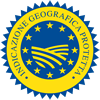Description
Burrata di Andria PGI is a spun paste cheese made from cow 's milk and obtained by mixing cream and cheese. The outer skin is made exclusively of spun paste, which contains a mixture of cream and hand-pulled spun paste.
Production Area
The production area of Burrata di Andria PGI is within the entire territory of the Apulia Region.
Production Method
The milk can be either raw or pasteurised at 72 °C for 15 seconds, and must be heated to 35-37 °C. Curdling, which is obtained with natural calf rennet, is preceded by fermentation with the addition of food-grade acids (citric or lactic acid), a starter culture or a whey starter. The curd, broken into lumps the size of hazelnuts, is separated from the starter culture and left to rest until the lactose has fully converted into lactic acid. The cheese is spun with boiling water and then salt may be added. Part of the spun paste is separated into strings by hand and then cooled in water until it forms a spongy mass; this is then mixed with cream to form the filling (stracciatella). The remainder of the spun paste is used to cover the sacks that have been filled with stracciatella, which are then carefully closed at the top. The wheels are then hardened in cold water. The wheels may then be salted by immersing them in brine, if they were not already salted during the spinning process, or in cream.
Appearance and Flavour
Burrata di Andria PGI is a small, round sack of spun paste cheese that is white and shiny, with a characteristic hand-closed top that is large enough to permit the top to be tied with food-grade raffia. The filling, or stracciatella, has a spongy consistency and is made of hand-pulled spun paste cheese that has been immersed in cream. Burrata di Andria PGI weighs between 100 g and 1 kg and the thickness of skin is greater than or equal to 2 mm. The taste is given to the mixture of fresh or cooked milk, butter and cream.
History
The story that Burrata di Andria was invented in an old farmhouse in the early twentieth century, by a certain Lorenzo Bianchino, has been handed down orally. It is said that due to heavy snowfall he was unable to take the milk into town, and therefore needing to transform it and, more importantly, use the cream, he followed the production method used for mantèche (skins of mature spun paste in which butter was kept) to try and produce a fresh product. He therefore decided to mix the remnants of spun paste processing with some cream and wrap the mixture in a skin also made of spun paste cheese. One of the first mentions dates back to 1931, in the Touring Club Guide, and it was an instant success, so much so, that the Shah of Iran became one of its greatest enthusiasts.
Gastronomy
Burrata di Andria PGI must be eaten fresh. Its short shelf life is an indication of the continuous link between traditional production and territory. Nonetheless, Burrata di Andria PGI enjoys an excellent reputation among consumers, as demonstrated by its diffused presence on the menus of many restaurants around the world, where the value of this product is highlighted by specifying its Andrian origins.
Marketing
The product is sold year-round as Burrata di Andria PGI. It is packed in bags made of a food-grade plastic-coated material or of other legally permitted materials, at times wrapped in food grade plastic-coated paper or another material, and tied at the top; wrapped in sheets of green plastic or other materials; and in trays, tubs, or glass jars and/or immersed in liquid. The product should be stored at a temperature of 4-6 ° C. The product can be sold in packs of between 100 g and 1 kg.
Distinctive Features
When cut, Burrata di Andria PGI has a filling of cream and stringy spun paste cheese that has been "shredded" by hand. The term "stracciatella" originates from this processing method.






















